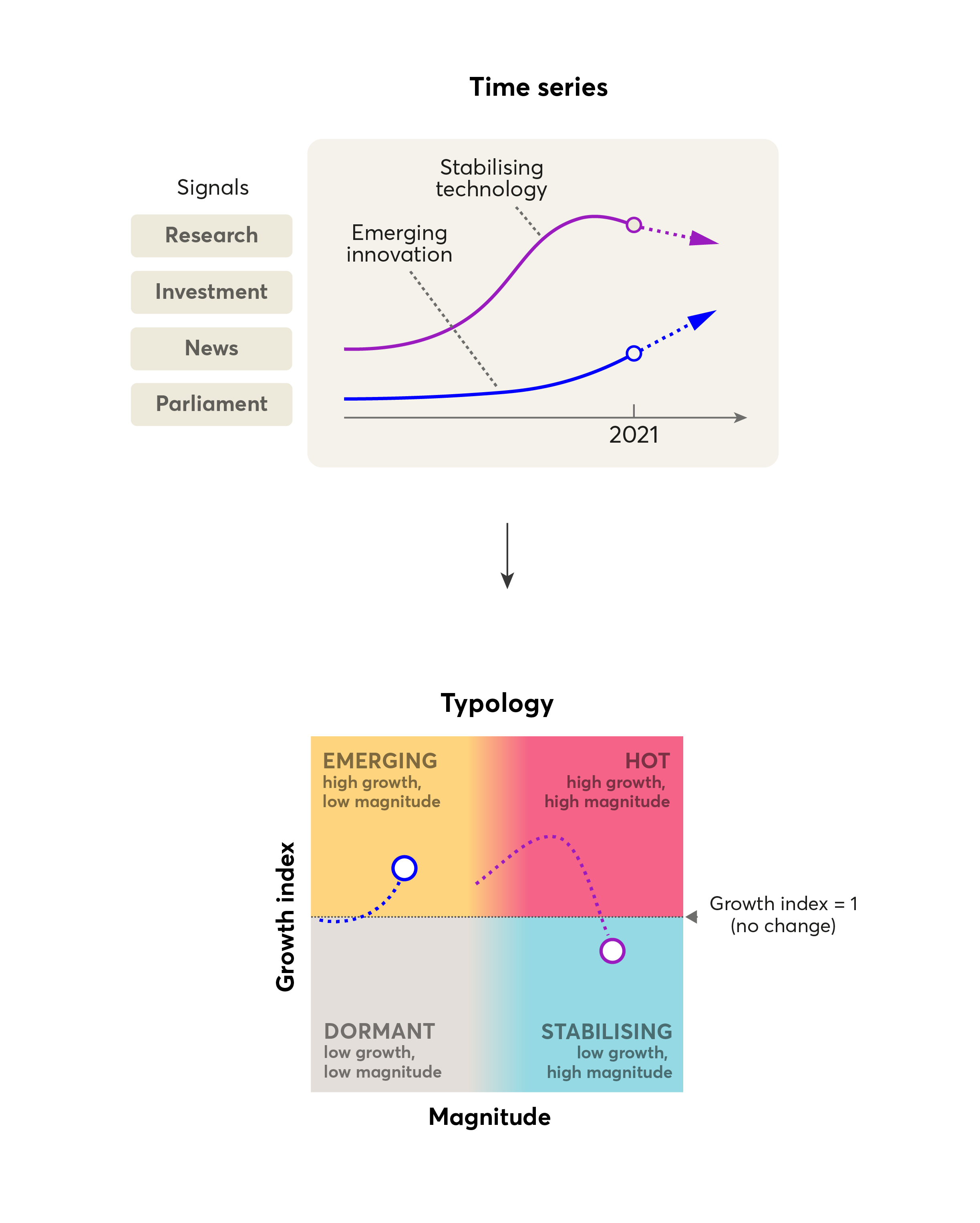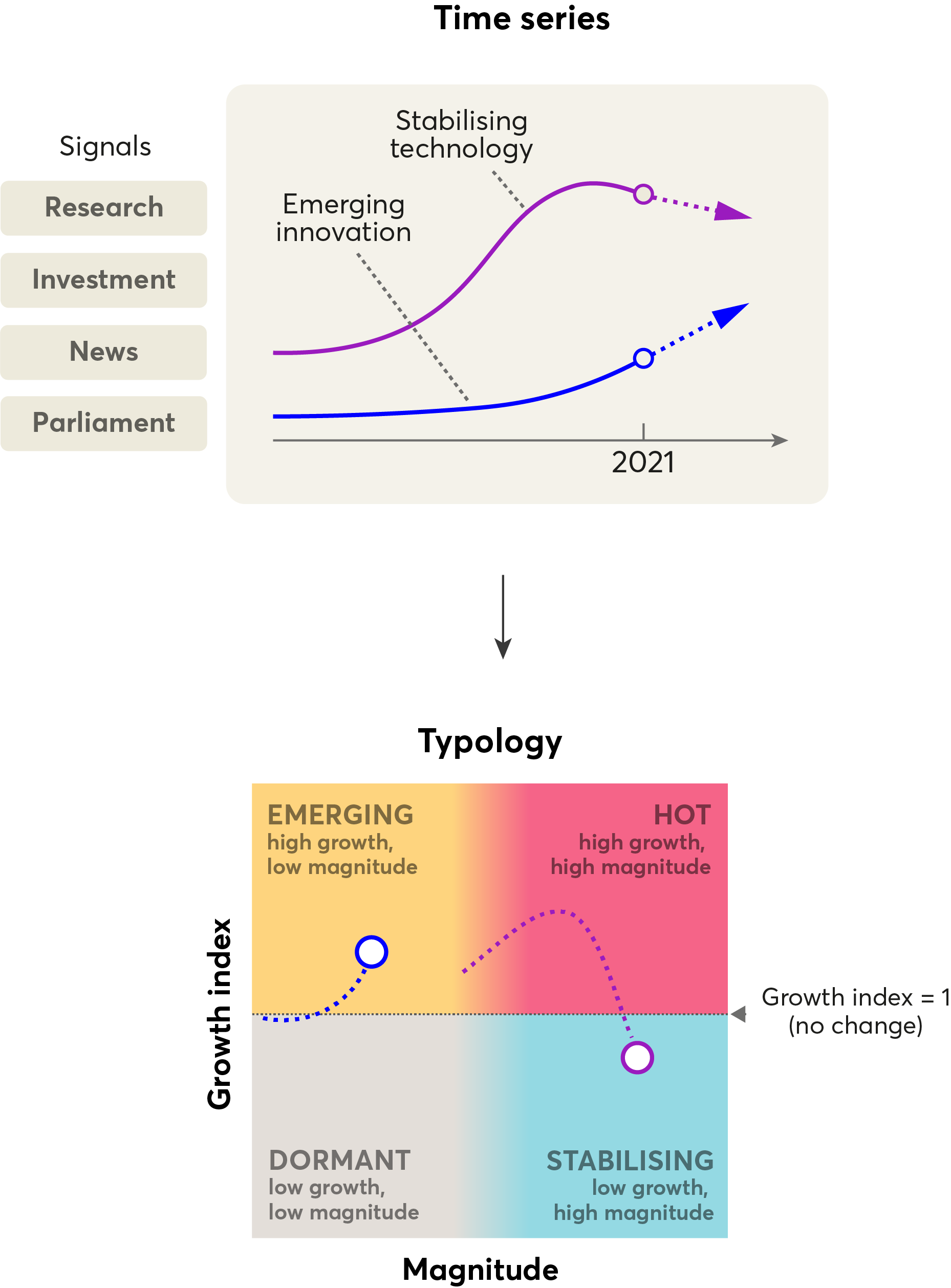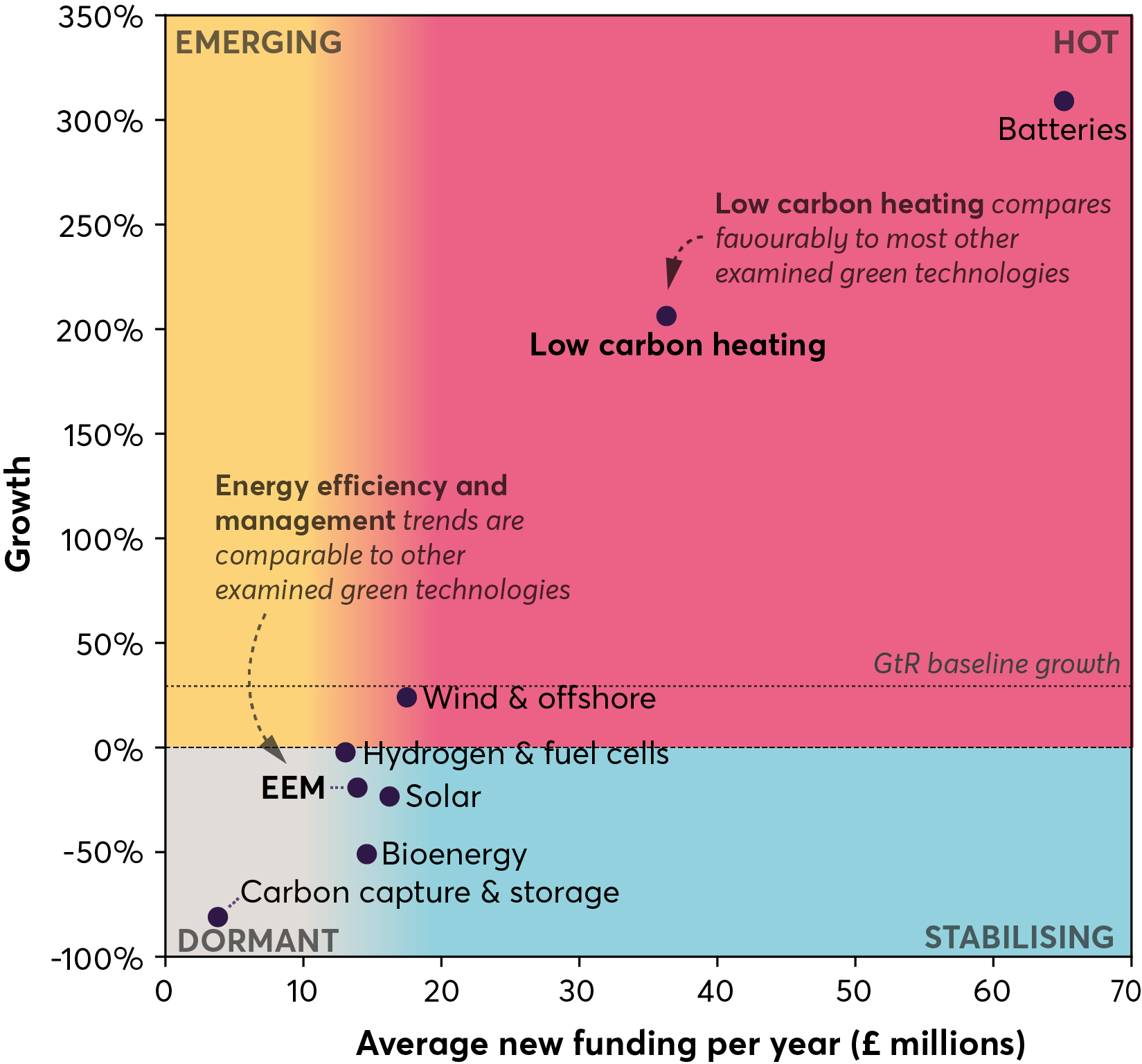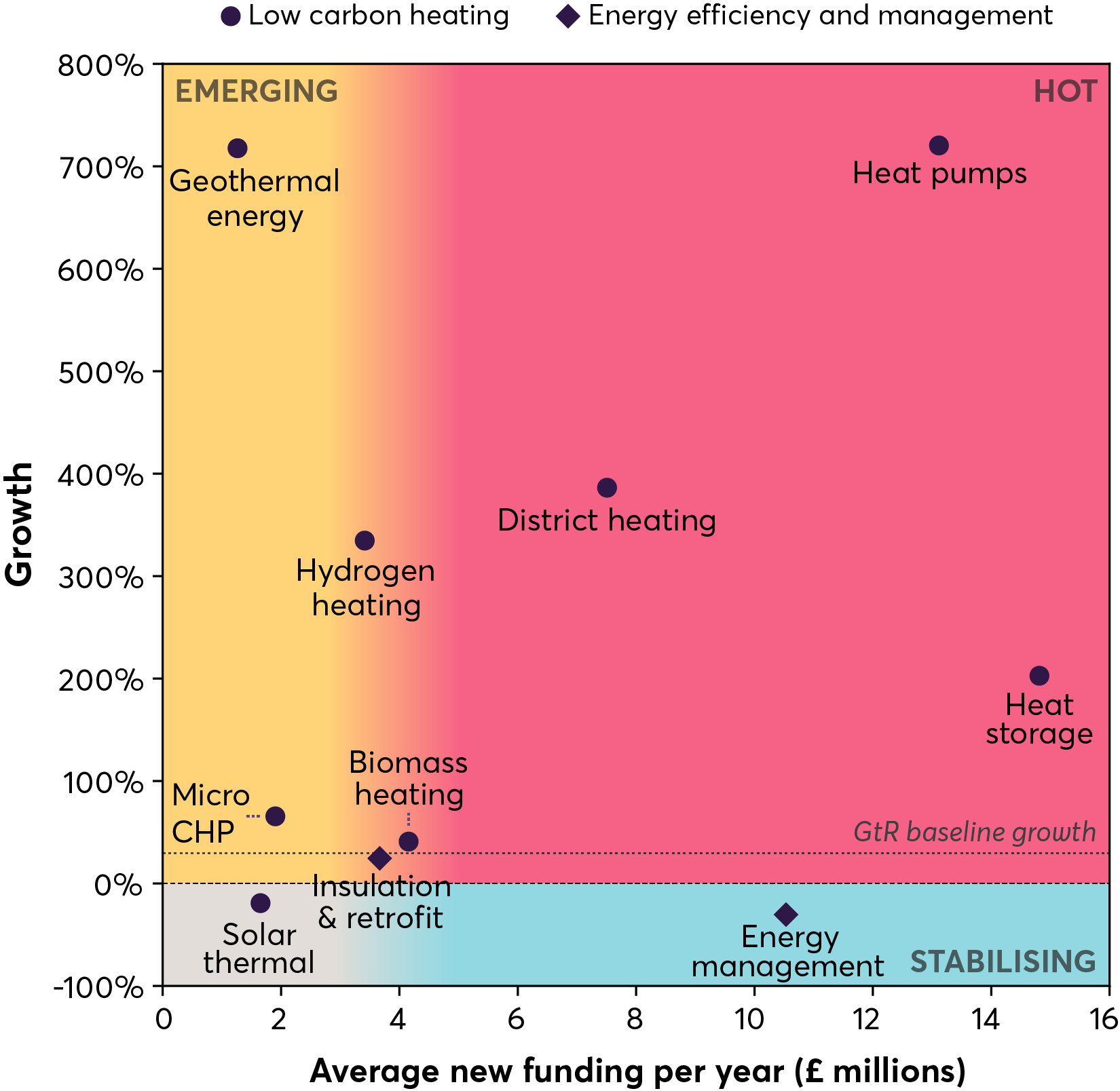Innovation Sweet Spots
Which green technologies are at a tipping point?

Climate change mitigation is one of the defining challenges of our era. The UK’s ability to reach its net-zero goal hinges on innovation such as ‘green’ technologies being successfully developed and adopted widely. Nesta is committed to supporting the transition of the country’s 29 million homes to sustainable, low-carbon heating and helping tackle climate change.
Nesta has developed a novel horizon-scanning approach for analysing these green innovations and technologies. Our findings suggest that, among green technologies, low-carbon heating stands out in terms of attracting significant public investment in research and development, and it shows a growing presence in the public discourse. However, we do not see similarly strong signals from venture capital investment.
Our experimental approach tracks the trajectory of innovations for social good and anticipates when they are approaching a ’tipping point’, where we can spot a promising convergence of signals from the research, investment, news discourse and policy spheres. In this way, we hope to cut through the hype and develop a clearer picture of whether a given innovation can make the leap to large-scale impact.
To achieve this, we leveraged data science and machine-learning methods, and evaluated insights across several large datasets that are commonly only analysed in isolation. We assessed the trends in research funding, business investment, news coverage and parliamentary debates related to specific technologies, and then placed them across four categories: dormant, emerging, hot or stabilising (see Figure 1).
We have applied this approach to technologies that could help tackle climate change, particularly focusing on those that can help decarbonise heating and so reduce household carbon emissions. To the best of our knowledge, this is the first time that trends in low-carbon heating and energy efficiency and management (EEM) technologies have been mapped using such a wide range of signals. We have also developed several recommendations for action based on the findings of our report.

Figure 1. Typology of time series trends. Magnitude is calculated as the average value of the signal (eg, amount of research funding) across a five-year period, whereas growth is the percentage increase of the (smoothed) signal value in the same time period.

Figure 1. Typology of time series trends. Magnitude is calculated as the average value of the signal (eg, amount of research funding) across a five-year period, whereas growth is the percentage increase of the (smoothed) signal value in the same time period.
Figure 1. Typology of time series trends. Magnitude is calculated as the average value of the signal (eg, amount of research funding) across a five-year period, whereas growth is the percentage increase of the (smoothed) signal value in the same time period.

Figure 2. Research funding trends across various green technologies. Average magnitude and growth between 2016 and 2020, based on analysis of the UKRI's Gateway to Research (GtR) portal data.
Figure 2. Research funding trends across various green technologies. Average magnitude and growth between 2016 and 2020, based on analysis of the UKRI's Gateway to Research (GtR) portal data.
Our analysis of research projects funded by UK Research and Innovation (UKRI) indicates a strong level of support for low-carbon heating and energy efficiency and management.
The research funding awarded to low-carbon heating technologies has increased by about 200 percent between 2016 and 2020, with an estimated £36 million in new funding per year on average (Figure 2). This compares favourably to the baseline UKRI funding increase across all research disciplines of about 30 percent and even surpasses the research funding directed toward other green technologies such as solar, bioenergy or wind and offshore energy that we have used for comparison.
About 60 percent of the low-carbon heating research projects have been funded by research councils and 40 percent by Innovate UK, indicating that this resourcing is spread across fundamental research as well as development and commercialisation of new technologies.
This is an encouraging indicator of innovation, as it shows there is a growing body of well-resourced research into low-carbon home heating.

Figure 2. Research funding trends across various green technologies. Average magnitude and growth between 2016 and 2020, based on analysis of the UKRI's Gateway to Research (GtR) portal data.
Among low-carbon heating technologies, heat pumps and heat storage appear particularly ‘hot’ in terms of research activity, followed by district heating (Figure 3). Strikingly, funding for projects that mention heat pumps has increased about eightfold between 2016 and 2020. This is owing to several large recent projects that integrate heat pumps into wider heating systems.
Meanwhile, we have classed research on hydrogen heating and geothermal energy as ‘emerging’ in our taxonomy because they exhibit high growth but have a smaller number of projects and funding.

Figure 3. Research funding trends for decarbonising heating. Average magnitude and growth between 2016 and 2020, based on analysis of the UKRI's Gateway to Research (GtR) portal data.

Figure 3. Research funding trends for decarbonising heating. Average magnitude and growth between 2016 and 2020, based on analysis of the UKRI's Gateway to Research (GtR) portal data.
Figure 3. Research funding trends for decarbonising heating. Average magnitude and growth between 2016 and 2020, based on analysis of the UKRI's Gateway to Research (GtR) portal data.
Our analysis also suggests that news coverage and parliamentary debates on some low-carbon heating technologies, such as heat pumps and hydrogen, have ramped up.
A flurry of interest about heat pumps around 2008 was followed by a period of diminished coverage, but now we see heat pumps are once again attracting renewed interest in parliament as well as in the news, where the discourse appears increasingly focused on practical aspects of implementation such as cost and installation in homes.
We find that this bears resemblance to the typical evolution of expectations around innovations. One example is the widely referenced Gartner® Hype Cycle™ (Figure 4).
In parallel, we observe a rising wave of The Guardian media coverage of hydrogen energy, with five times as many news articles published on its news site in 2020 compared to 2016 (Figure 5). As part of this wave, mentions of hydrogen heating have increased twofold since 2017 when hydrogen boilers were first featured in The Guardian.
Given the urgency of the climate crisis, the signals of building hype around hydrogen and its application for heating could be a cause for concern if the hype distracts from other, more mature low-carbon heating solutions such as heat pumps. The viability of hydrogen heating is yet to be demonstrated in forthcoming neighbourhood and village trials whilst the government plans to make major strategic decisions on hydrogen heating only in 2026, according to the recently published Heat and Buildings Strategy. There is evidence of continued scepticism among experts about the use of hydrogen for household heating.
Although low-carbon heating appears to be backed by substantial research funding support and increasing public interest, we find indications that this is not matched by an equally significant influx of venture capital investment.
Between 2016 and 2020, low-carbon heating as a whole attracted about 20 percent of the UKRI research funding across the green technologies we examined, but raised only four per-cent of the combined investment reported on the Crunchbase business information platform for the same technologies (Figure 6).

Figure 6. Missing investment in low carbon heating. Percentage of research funding reported in the UKRI's Gateway to Research portal and raised business investment reported in Crunchbase, across various green technologies in the UK between 2016 and 2020.
Figure 6. Missing investment in low carbon heating. Percentage of research funding reported in the UKRI's Gateway to Research portal and raised business investment reported in Crunchbase, across various green technologies in the UK between 2016 and 2020.
It could be that innovation on low-carbon heating technologies is primarily taking place internally within established companies: investment that would not be captured by the datasets we used. Another possibility is that investors have been waiting for the government to make a strong commitment to these technologies, for example, via the delayed Heat and Buildings Strategy which was published in October 2021.
This strategy relies heavily on the private sector to reduce the cost of heat pumps, while scaling up production, so there is a pressing need to overcome any potential barriers to attracting private investment if low-carbon heating is to reach a tipping point. This growth will require innovation in business and financing models, alongside efforts to tackle skills shortages, incentivise consumers and tackle higher levies on electricity than gas.
In the next sections of this article, we expand on the findings and methodology that underpin a set of proposals for action (summarised below).
Proposals for action
The findings on trends in low-carbon heating suggest the following actions:
- We have technologies to decarbonise household heating, but now need commercial pathways for deploying and scaling them. To achieve this goal investors, businesses, funders and government should support the development of innovative business and financing models – for example, ‘heat as a service’ or schemes that attach the cost of heating decarbonisation to home mortgages.
- For the low-carbon heating sector to flourish and attract investment in future, the policy environment will need to be supportive. To facilitate this, the government should undertake measures to tackle skills shortages among installers as there are currently not enough trained people to decarbonise UK heating quickly enough, and to provide stable, well-designed consumer incentives for low-carbon heating and energy efficiency. Current schemes are not substantial enough and some previous approaches were too complex and short lived. Government should also ensure commitments to rebalance energy prices are implemented rapidly so that electric heating can compete with gas.
- Consumers should not be distracted from adopting more mature decarbonisation technologies such as heat pumps by what appears to be early-stage hype around hydrogen heating.
- The government’s Net Zero Research and Innovation Framework should explicitly highlight a fair heating transition as a priority research and innovation challenge to be addressed. The contributions towards this challenge by the research and business communities could be monitored using datasets such as those we have used in this project.
The methodology developed for this pilot, alongside Nesta’s previous work on innovation mapping, demonstrates the possibilities for machine learning and data-driven horizon scanning to strengthen insight into the UK’s innovation system. To build on this potential we recommend that:
- As part of its review of technology, the Ministerial Council and Office for Science and Technology Strategy should consider using evidence from data-driven horizon scanning and from civil society organisations with deep knowledge of the social challenges and context for the deployment of technologies.
- Public datasets related to research and business activity should be labelled more comprehensively to allow easier access to timely insights about trends relevant to social challenges.
- Whilst it is subject to commercial sensitivities, data on company investments in R&D would provide considerable insight into trends in innovation currently hidden from view. One way analysis of these trends might be made possible is through the creation of data trusts.
Going forward, we will continue to refine our methodology and apply it to other social challenges to spot new trends, opportunities or stagnation. We will also explore the predictive potential of these datasets, in order to support researchers, businesses, policymakers and investors take a more anticipatory approach to innovation for social good.
If you have any advice or want to discuss the project, we’d like to hear from you - please get in touch.

GARTNER and HYPE CYCLE are a registered trademark and service mark of Gartner, Inc. and/or its affiliates in the U.S. and internationally and are used herein with permission